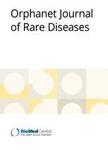版权所有:内蒙古大学图书馆 技术提供:维普资讯• 智图
内蒙古自治区呼和浩特市赛罕区大学西街235号 邮编: 010021

作者机构:Univ Lyon Lyon France Univ Lyon 1 Fac Med Lyon Sud CTO EMR3738 Oullins France Univ Paris Est Creteil AP HP GH H Mondor Pharmacol Lab Creteil France Univ Paris Est Creteil AP HP GH H Mondor Ctr Reference Syndromes Drepanocytaires Majeu Creteil France Hosp Civils Lyon Hop Croix Rousse Lyon France
出 版 物:《ORPHANET JOURNAL OF RARE DISEASES》 (罕见疾病与罕用药品杂志)
年 卷 期:2011年第6卷第1期
页 面:1-12页
核心收录:
学科分类:0710[理学-生物学] 1002[医学-临床医学] 1001[医学-基础医学(可授医学、理学学位)] 100201[医学-内科学(含:心血管病、血液病、呼吸系病、消化系病、内分泌与代谢病、肾病、风湿病、传染病)] 10[医学]
基 金:OTL-Pharma Laboratories Centre de reference pour les syndromes drepanocytaires majeurs Laboratoire de Pharmacologie, AP-HP, GH H
主 题:Mean Corpuscular Volume Objective Function Value Visual Predictive Check Fetal Hemoglobin Residual Error Model
摘 要:Background: Hydroxyurea (HU) is the first approved pharmacological treatment of sickle cell anemia (SCA). The objectives of this study were to develop population pharmacokinetic(PK)-pharmacodynamic(PD) models for HU in order to characterize the exposure-efficacy relationships and their variability, compare two dosing regimens by simulations and develop some recommendations for monitoring the treatment. Methods: The models were built using population modelling software NONMEM VII based on data from two clinical studies of SCA adult patients receiving 500-2000 mg of HU once daily. Fetal hemoglobin percentage (HbF %) and mean corpuscular volume (MCV) were used as biomarkers for response. A sequential modelling approach was applied. Models were evaluated using simulation-based techniques. Comparisons of two dosing regimens were performed by simulating 10000 patients in each arm during 12 months. Results: The PK profiles were described by a bicompartmental model. The median (and interindividual coefficient of variation (CV)) of clearance was 11.6 L/h (30%), the central volume was 45.3 L (35%). PK steady-state was reached in about 35 days. For a given dosing regimen, HU exposure varied approximately fivefold among patients. The dynamics of HbF% and MCV were described by turnover models with inhibition of elimination of response. In the studied range of drug exposures, the effect of HU on HbF% was at its maximum (median I-max was 0.57, CV was 27%);the effect on MCV was close to its maximum, with median value of 0.14 and CV of 49%. Simulations showed that 95% of the steady-state levels of HbF% and MCV need 26 months and 3 months to be reached, respectively. The CV of the steady-state value of HbF% was about 7 times larger than that of MCV. Simulations with two different dosing regimens showed that continuous dosing led to a stronger HbF% increase in some patients. Conclusions: The high variability of response to HU was related in part to pharmacokinetics and to pharmacodyna